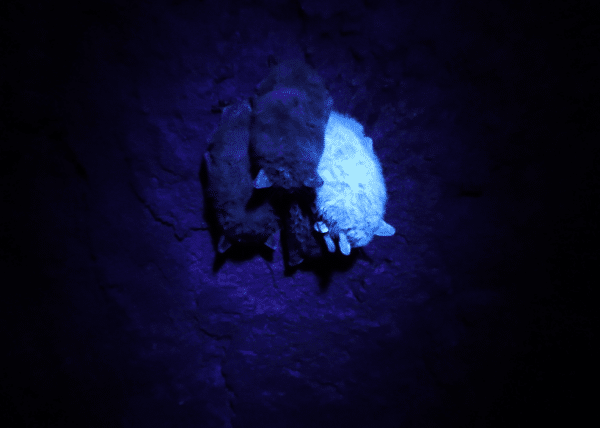Nov. 27, 2018
Researchers have long known how diseases are spread, most of which involve contracting germs through air, feces, mucus membranes, blood or other bodily fluids. But because germs are naked to the human eye, seeing the process in which these pathogens move has remained a mystery. Until now.
A team of biologists from several institutions throughout the United States, including Northern Arizona University researchers Jeffrey Foster and Katy Parise, looked at disease transmission in bats. What they found revealed previously unknown connections can spread diseases between species and lead to large-scale outbreaks, like white-nose syndrome—responsible for killing millions of North American bats since 2006.
The idea of the study, which was recently published in Nature, was to track how disease was spread within hibernating bats. In order to do so, the researchers used colored dust—a visible alternative to a disease that could mimic how a fungal pathogen spreads from one individual to another.
“Tracking an actual pathogen is exceedingly hard; this dust proved to be a useful surrogate for the fungus causing this disease,” Foster said. “Bats were individually dusted with a fluorescent powder, visible only when a UV light is used, and then observed weeks later to see where the dust had spread.”
The fluorescent dust used in this study proved to be highly effective at revealing previously unrecognized connections among the bats. Researchers led by Joe Hoyt at the University of California, Santa Cruz conducted the study at eight hibernation sites (mostly abandoned mine tunnels) in the upper Midwest, each site home to as many as four species of bats. At the start of the study, the pathogen causing white-nose syndrome had not yet reached these populations.
The researchers first surveyed the bats and characterized their social networks, measuring direct physical contacts between bats hibernating together in groups, as well as additional connections made by bats moving between groups. Then they applied the fluorescent dust to selected bats in early winter, using a different color for each individual. In late winter, the researchers returned to see where each color of fluorescent dust ended up. Using the dust patterns, researchers were able to track contacts between bats themselves, and also between bats and their surrounding habitat. Then, a network of how the dust was spread was created.
NAU’s Pathogen and Microbiome Institute specializes in disease research. Foster, associate professor of biology, and lab manager Parise’s role in the study was to screen samples to detect the actual fungus, and compare it to how the dust spread.
“These results from the surrogate pathogen support our results from the true fungal pathogen,” Foster said. “They appear to spread in a very similar way.”

The fungal pathogen that causes white-nose syndrome arrived in the area after the fluorescent dust studies were conducted, and the researchers tracked its spread at each site. They found that the actual transmission dynamics of the disease were better explained by the sum of all the connections revealed in the dust studies than by just using the social networks previously seen in these bats.
One of the puzzling features of white-nose syndrome is its ability to spread through a community of bats during the winter, when the animals are hibernating 99.5 percent of the time, briefly rising from hibernation every two to three weeks. Yet the dust studies show the bats move around enough to have significantly more connections than can be observed in their hibernation groups.
Despite what researchers now know about disease transmission, the fact remains: There is no stopping the spread of white-nose syndrome.
The good news to come out of this study is what it means for other populations.
“It is exceedingly difficult to track contacts between people and realistically understand how a pathogen such as a virus or bacteria gets spread from one individual to another,” Foster said. “Understanding transmission between people (or among other organisms) is a holy grail of disease research. This approach in bats is a first step in measuring transmission in a realistic way.”
In addition to Foster and Parise, the project was led by Hoyt and Marm Kilpatrick at UC Santa Cruz and Kate Langwig at Virginia Tech. This work was supported by the National Science Foundation, the U.S. Fish and Wildlife Service and Bat Conservation International.
Carly Banks | NAU Communications
(928) 523-5582 | carly.banks@nau.edu




